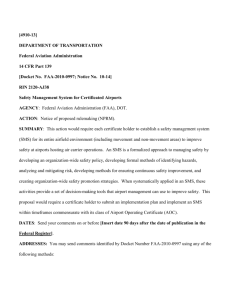17.3 Committee Board Assignments and Status
advertisement
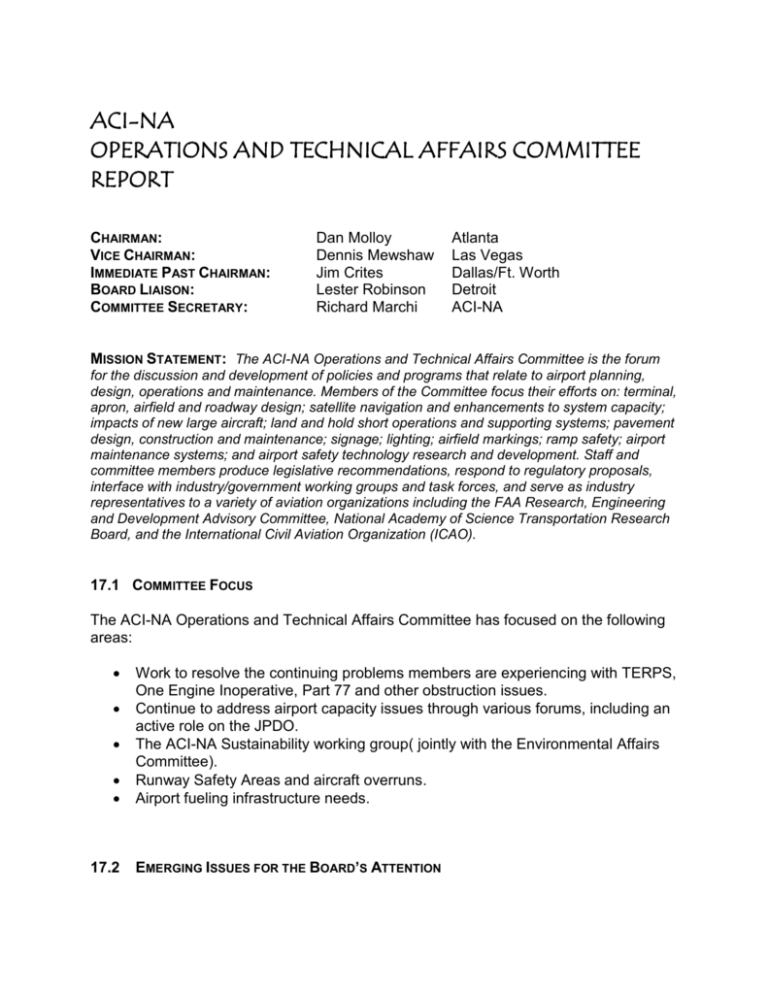
ACI-NA OPERATIONS AND TECHNICAL AFFAIRS COMMITTEE REPORT CHAIRMAN: VICE CHAIRMAN: IMMEDIATE PAST CHAIRMAN: BOARD LIAISON: COMMITTEE SECRETARY: Dan Molloy Dennis Mewshaw Jim Crites Lester Robinson Richard Marchi Atlanta Las Vegas Dallas/Ft. Worth Detroit ACI-NA MISSION STATEMENT: The ACI-NA Operations and Technical Affairs Committee is the forum for the discussion and development of policies and programs that relate to airport planning, design, operations and maintenance. Members of the Committee focus their efforts on: terminal, apron, airfield and roadway design; satellite navigation and enhancements to system capacity; impacts of new large aircraft; land and hold short operations and supporting systems; pavement design, construction and maintenance; signage; lighting; airfield markings; ramp safety; airport maintenance systems; and airport safety technology research and development. Staff and committee members produce legislative recommendations, respond to regulatory proposals, interface with industry/government working groups and task forces, and serve as industry representatives to a variety of aviation organizations including the FAA Research, Engineering and Development Advisory Committee, National Academy of Science Transportation Research Board, and the International Civil Aviation Organization (ICAO). 17.1 COMMITTEE FOCUS The ACI-NA Operations and Technical Affairs Committee has focused on the following areas: 17.2 Work to resolve the continuing problems members are experiencing with TERPS, One Engine Inoperative, Part 77 and other obstruction issues. Continue to address airport capacity issues through various forums, including an active role on the JPDO. The ACI-NA Sustainability working group( jointly with the Environmental Affairs Committee). Runway Safety Areas and aircraft overruns. Airport fueling infrastructure needs. EMERGING ISSUES FOR THE BOARD’S ATTENTION Safety Management Systems: FAA intends to adopt the Safety Management System (SMS) standards promulgated by ICAO last year through a rulemaking to amend Part 139 in 2007. They have indicated that they intend to retain the core of the existing safety regulations, but “layer” additional SMS requirements on to Part 139. Staff recently commented on a draft SMS advisory circular, asking FAA to file a difference with ICAO (which is the official way of declining to adopt an ICAO standard) and pointing out the difficulty of accomplishing the SMS integration with Part 139. Briefly, SMS was originally developed by as a means of identifying and quantifying risks, determining the acceptable target level of safety (TLS) and devoting the management and other resources needed to manage those risks to achieve the TLS. Although it is an excellent approach to safety, it is completely inconsistent with the existing, highly proscriptive, safety requirements of Part 139. It is unclear how airports would independently determine target levels of safety and the appropriate risk mitigation for such issues as runway overruns in a world where FAA dictates every feature of mandated Runway Safety Areas. In addition SMS would require the preparation of extensive additional monitoring documentation and the creation of staff dedicated to SMS administration. 17.3 COMMITTEE BOARD ASSIGNMENTS AND STATUS New Large Aircraft. The A380 certification flight test program is nearing completion with the decision on whether the airplane can be operated on 150 foot wide runways in the United States still unresolved at this time. Several European civil aviation authorities have decided to allow operations on 150’ wide runways. FAA is still reviewing certification data, but is expected to agree. If the A380 is allowed to operate on existing width runways, member airports expecting service by the airplane will save the considerable expense of widening existing runways. However, those airports will most likely be required to augment existing shoulders to provide additional blast protection for the A380’s more widely spaced outer engines. Given that Boeing has announced a launch of the stretched B-747-8, which will also be a Design Group 6, ICAO Code E, airplane, the activities of the ACI-NA A380 working group will be expanded to include that additional aircraft. Runway Safety Areas. Members and Staff are participating in an ACRP project to better quantify the risks involved in airplane overruns in order to target resources on those overruns that present significant risk. ACRP funding for this project has been approved and a contractor has been selected to review the statistical history of overruns and evaluate alternatives to FAA’s standard EMAS. A related project seeks an evaluation of stiffer EMAS foams that will decelerate aircraft in less distance than the current designs, allowing easier installation at airports with constrained runways and potentially reducing maintenance costs by reducing the area of EMAS beds needing to be maintained. TERPS, Part 121, Part 77 and Other Obstruction Issues. As previously reported, FAA filed an NPRM to amend Part 77 that addresses some of the obstruction issues that have been troublesome for members, such as the need to provide notice on all obstruction filings, extending the comment period to 60 days and including public procedures at private airports in the Part 77 process. However, the notice specifically excluded the One Engine Inoperative issue, claiming that the issue would be treated separatly. Staff solicited input from the committee on the Part 77 NPRM and submitted comments on September 11, 2006, pointing out the NPRM’s failure to address this issue. After reviewing the comments and discussing the NPRM at the Reno meeting, the committee felt that this issue should be added to our legislative agenda for action as part of the reauthorization initiative. The anticipated outcome would be a legislative directive requiring FAA to treat all obstructions having similar impact on the efficiency of the National Airspace System in the same fashion as Part 77 obstructions are currently treated. Status of the “Hurricane Action Group”. ACI-NA staff continued to work with the Southeast Airports Disaster Operations Group (SEADOG) during the 2006 hurricane season. Staff participated in SEADOG coordinating calls, which were activated at the start of the 2006 season and for tropical storm Ernesto. Although the past hurricane season was very mild, we will continue to participate in SEADOG planning efforts. Staff also assisted with the organization of a western airports disaster preparedness/ recovery group and participated in the initial organizational meeting in Seattle. 17.4 CONTINUING ISSUES IN THE COMMITTEE WORK PROGRAM JPDO Next Generation Air Traffic Control System (NGATS). Although starting very slowly, the Joint Planning and Development Office (JPDO) is beginning to make progress on development of the Next Generation Air Traffic Control System (NGATS). Staff, airport and associate members recently participated in a two day JPDO workshop to identify airport issues that could impede the NGATS goal of handling up to a tripling of traffic in the year 2025. Committee Chairman, Dan Molloy (ATL) summarized the results in a presentation to Kate Lang at the end of the workshop. Briefly, he emphasized the need for: substantial improvements in passenger and baggage security screening processes; successful development of technologies and procedures that would eliminate wake vortex constraints and permit operations to closely spaced parallel runways in all whether conditions; endorsed the NGATS goal of pursuing additional runways, including construction of closely spaced infill runways, where feasible; identified environmental constraints as a significant risk to achieving NGATS goals; noted that financing of the necessary airport capital projects at key airports would be a far less severe constraint than the other factors mentioned. Committee members and staff will continue to track this issue which will play an important role in the reauthorization debate. Notice of Landing Assessment Policy. Following the overrun accident at Midway airport, FAA issued a clarification of the air carriers’ obligation to assure that sufficient runway length is available for safe operations. The policy requires carriers to make an assessment of the required landing length based on actual runway conditions being experienced at the time of landing during winter operations. In addition, the policy established a new requirement that carriers provide a safety margin of 15% beyond the length actually required to land. ACI-NA provided comments urging FAA to consider the impact of the new 15% margin on schedule integrity, delays and diversions, and to be prepared to make adjustments in response to any disruptions. We also urged them to publish the proposed change as a notice of proposed rulemaking in the federal register, solicit public comment and perform an economic impact analysis rather than implementing the change by issuing a policy statement. Subsequently, FAA agreed to pursue the change through a rulemaking with full public input and urged carriers to comply with the policy, voluntarily. Airport Cooperative Research Program (ACRP). A third meeting of the ACRP Oversight Board (AOB) to prioritize research project requests will occur in late January. The board includes airport representatives Jim Wilding (Chairman), Jeff Hamiel (Vice Chairman) Steve Grossman, Kevin Dolliole, Jim Crites, Carolyn Motz, Richard Hunter and Gina Marie Lindsay, in addition to staff representing ACI-NA and AAAE. The Board will select additional research projects at that time. Currently, individual project oversight panels are meeting to direct the preparation of RFP’s to conduct the research and monitor project progress. ACI-NA airport members are participating extensively on the individual research project oversight panels. 17.5 OTHER ACTIVITIES Committee members and staff are participating in an ACI-NA sustainability working group exploring current best practices by airports and which will eventually result in the development of LEED criteria for terminal design, as well as provide a focus on life-cycle investment analysis. Participated in an alternative fuels planning workshop sponsored by FAA and the Civil Aviation Alternative Fuels Initiative. The primary alternative fuel issues for airports are an anticipated reduction in pollutants and possible incompatibility with existing fueling infrastructure. Engaged with other staff in preliminary reauthorization planning and FAA discussions. Members and staff participated in the FAA Airport Compatibility Planning Committee. Continued planning for a second, two-day workshop on alternative construction delivery methods organized jointly with the Associated General Contractors and the Airports Consultants Council. Continued to monitor CDC and FAA pandemic flu and quarantine planning activities.
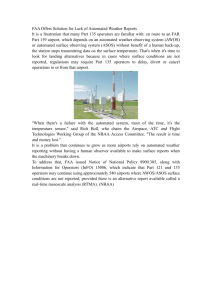
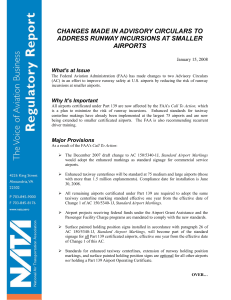
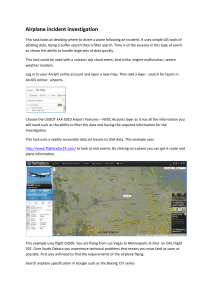
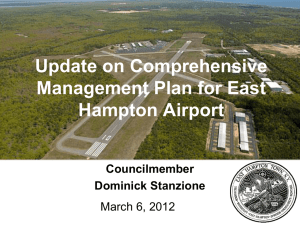

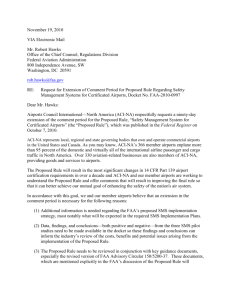
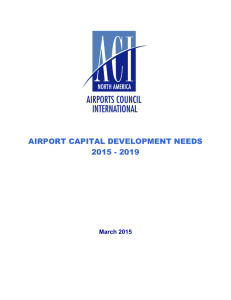
![[4910-13] DEPARTMENT OF TRANSPORTATION Federal Aviation](http://s3.studylib.net/store/data/008735079_1-ce8e18ac784436c33d782b9c03a01cfd-300x300.png)
